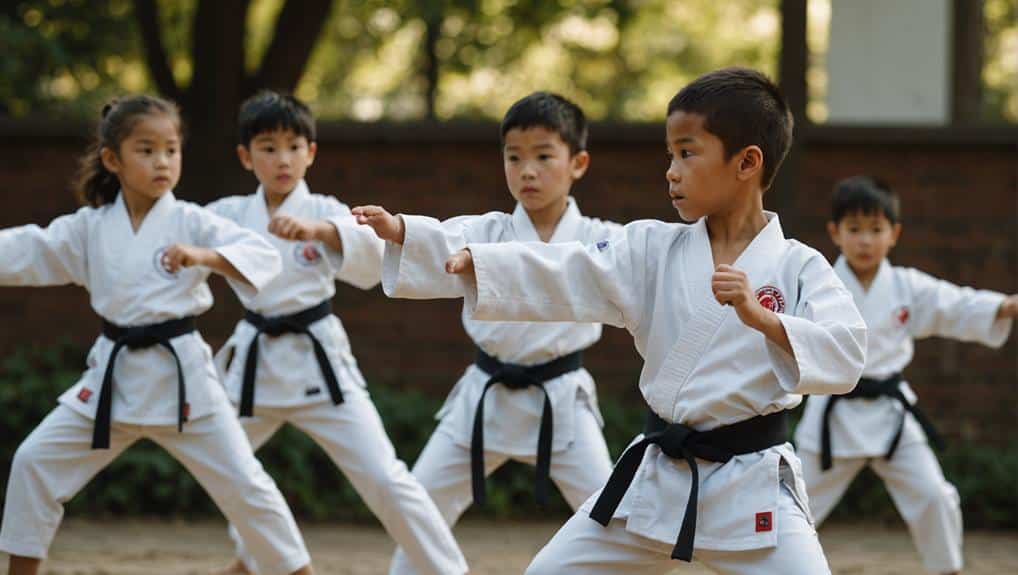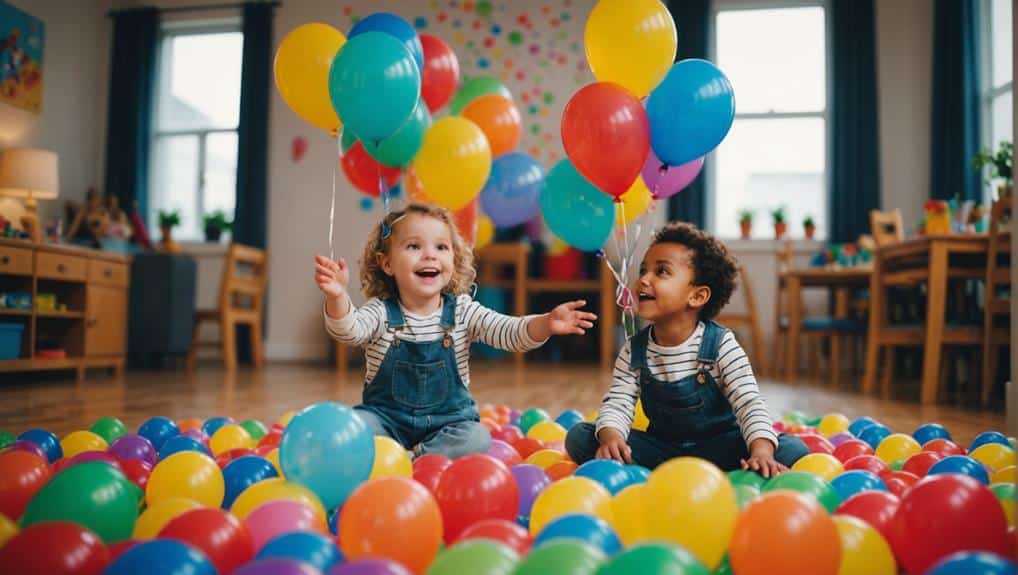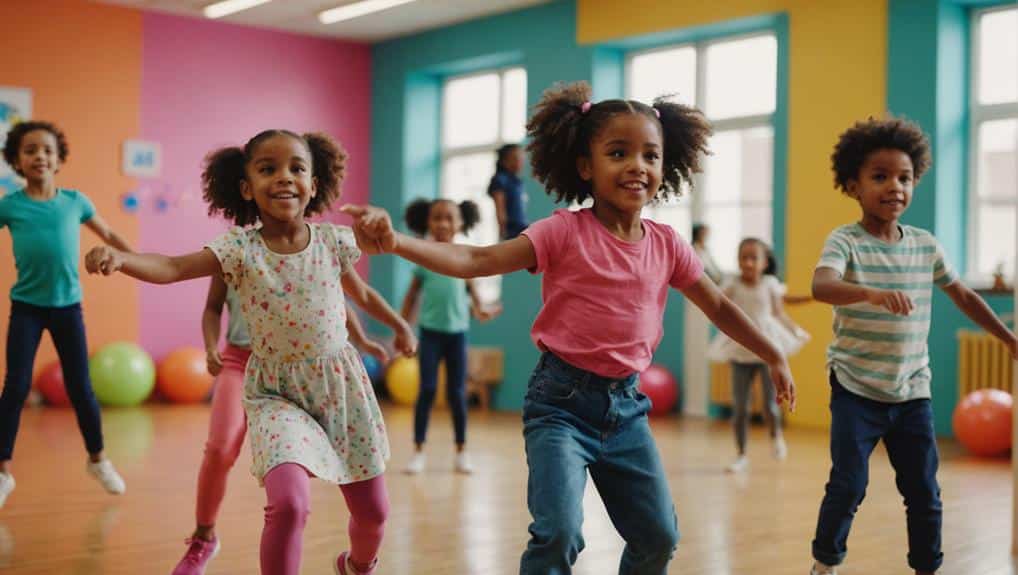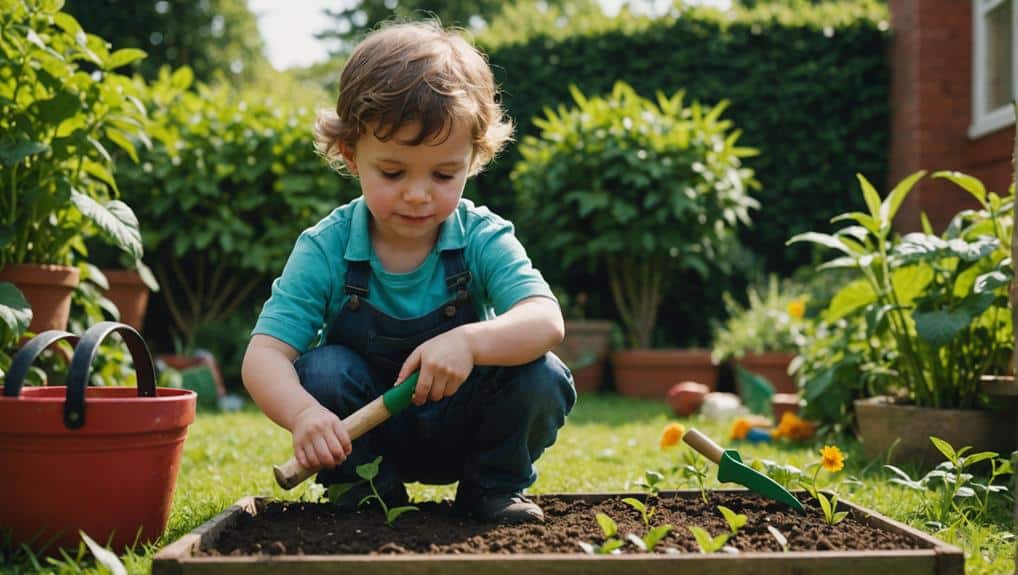Developing motor skills in children aged 3-8 is a critical aspect of their overall growth, contributing enormously to their physical, cognitive, and social development. Various activities, from trampoline exercises and playground games to handwriting and gardening tasks, can offer engaging ways to foster these skills. This discussion will explore ten activities designed to enhance balance, coordination, agility, and strength, with the added benefits of encouraging creativity and social interaction. But how do these activities uniquely impact the development of motor skills in children? Let’s explore.
Key Takeaways
- Encourage trampoline activities like bouncing and jumping to improve balance and coordination and enhance sensory diet.
- Introduce playground exercises such as swinging and rope climbing to strengthen core muscles and enhance motor skills.
- Promote riding tricycles and scooters, setting up obstacle courses to enhance balance and coordination.
- Plan indoor dance parties that involve jumping, twisting, and clapping to promote coordination, rhythm awareness, and motor sequencing.
Exploring OT Motor Skills Games
Delving into the world of trampoline activities, it is worth mentioning that trampolines, particularly suitable for children aged 3-8, play an essential role in improving balance and are a vital part of a sensory diet, fostering motor skill development, socialization, and physical activity when used safely and appropriately.
Indoor trampoline parks offer a distinct platform for children to interact and develop their social skills while engaging in a fun and stimulating environment. The repetitive bouncing motion on a trampoline enhances motor skills, mainly balance and coordination. This, in turn, can translate into better performance in other physical activities and sports, contributing to a child’s overall development and health.
A mini-trampoline at home, under adult supervision, can provide additional opportunities for motor skill development. The key is strictly following safety rules, such as using a jump bar, to prevent injuries.
Learning Through Hopscotch
Shifting to the timeless game of hopscotch, it is essential to recognize its significant role in fostering balance, coordination, and gross motor skills among children aged 3-8. This classic game, which can be played either indoors or outdoors, requires children to hop and jump across a grid, thereby acquiring valuable physical skills.
Hopscotch is a versatile tool that provides an engaging way to improve motor skills. The physical demands of the game—jumping, hopping, and balancing—work together to enhance a child’s motor skills. Additionally, the game reinforces balance and coordination, vital skills for overall physical development, and prepares children for more complex movements in the future.
Beyond the physical benefits, hopscotch also offers a cognitive edge. As children navigate the numbered grid, they practice number recognition and sequencing, strengthening their mathematical abilities. Furthermore, the spatial awareness required in the game enhances their understanding of space and distance.
Setting up a hopscotch grid is simple and cost-effective, making it an accessible tool for parents and educators. As we aim to serve our young ones better, incorporating this multifaceted game into their routine can significantly improve their motor skills and cognitive development.
Martial Arts for Motor Skills

Turning our attention to martial arts, it’s worth mentioning how its practice greatly enhances strength in children’s legs and improves their overall motor skills. This discipline requires significant coordination and is an excellent way to promote body awareness, especially for children with sensory issues or ADHD.
| Martial Arts Benefits | Details | |
|---|---|---|
| 1 | Strength | Martial arts involve various activities that require using different muscle groups and developing strength in both the upper and lower body. |
| 2 | Coordination | The martial arts practice demands high coordination, honing children’s ability to perform complex movements gracefully and precisely. |
| 3 | Sensory Awareness | Martial arts classes provide a structured environment where children can enhance their body awareness, an essential aspect of motor skill development. |
Engaging in martial arts allows children aged 3-8 to work their core muscle groups, which are essential for balance and coordination. Moreover, the structured environment of a martial arts class offers a disciplined yet fun way of enhancing gross motor skills. Therefore, incorporating martial arts into children’s routines makes children’s motor development journey.
Playground Exercises for Balance
Playground exercises offer children a natural and enjoyable context to enhance their balance and motor skills. Activities such as swinging on swing sets or moving through unstable equipment like wobble bridges can significantly contribute to the development of weight shifting, leg coordination, and working the trunk muscles. By engaging in these playful tasks, children improve their balance and gross motor skills, which are essential for overall physical development.
Unstable Equipment Use
Harnessing the dynamic nature of unstable equipment such as rope ladders and wobble bridges can significantly enhance children’s balance skills by challenging their core muscles and coordination fun and engagingly. These playground exercises offer an exciting environment where children can explore and develop their physical capabilities while enjoying the thrill of play.
Unstable equipment imposes unpredictability, requiring the child to adjust their movements continuously. This not only strengthens their core muscles but also advances their balance development. Activities that include transitioning weight and coordinating leg movements can be especially advantageous. For instance, maneuvering across a wobble bridge encourages the child to shift their weight from side to side in response to the bridge’s movement.
Activities that leverage the distinct features of unstable equipment can give children the necessary challenges to enhance their motor skills. However, it is essential to ensure that these activities are age-appropriate and within the child’s abilities to ensure safety. With careful selection and supervision, unstable equipment can promote balance, coordination, and overall motor skill development in children aged 3-8.
Swing Set Activities
Building on the benefits of unstable equipment, swing sets also offer a dynamic platform for enhancing motor skills in children aged 3-8, specifically in balance and coordination. The rhythmical back-and-forth motion of swing set activities requires children to adjust their weight distribution, reinforcing their understanding of balance and coordination concepts.
Let’s consider the following table, which some practical swing set activities and their corresponding benefits:
| Swing Set Activity | Motor Skill Benefit |
|---|---|
| Swinging | Develops weight shifting and leg coordination |
| Climbing rope ladders | Enhances upper body strength and hand-eye coordination |
| Walking on wobble bridges | Strengthens trunk muscles and improves balance |
| Hanging from monkey bars | Develops arm strength and grip |
| Sliding down slides | Promotes leg strength and body balance |
Encouraging the use of such equipment has a twofold advantage. Not only do these activities promote physical development, but they also imbue a sense of accomplishment and confidence in children. As stewards of their well-being, we must continue fostering environments that allow exploring and refining these crucial motor skills.
Balloon and Bubble Playtime

Engaging children in a balloon and bubble playtime sparks their delight and sporadically builds their gross motor skills by chasing bubbles and popping balloons. Balloon play and bubble play are an excellent way to get children involved in physical activity, promoting the development of their motor skills in a fun and engaging way.
Balloon and bubble playtime provides many benefits for children aged 3-8. Here are some ways where motor skill development is enhanced:
- Children learn to balance, run, and jump while attempting to catch floating bubbles or balloons.
- The unpredictability of a balloon’s or bubble’s movement encourages quick reflexes and sud balloons in a bubble.
- Structured play, such as balloon volleyball, prompts children to move in specific ways, like zigzagging or kicking, honing their motor skills.
- The playful nature of balloons and bubbles stimulates creativity while contributing to physical health.
Let’s harness the power of balloon and bubble playtime to cultivLet’sotor skills in our young ones in an enjoyable manner.
Riding Tricycles and Scooters
While balloon and bubble playtime offer creative ways to improve motor skills, riding tricycles and scooters is another effective method. This fun yet challenging activity can significantly enhance a child’s balance, coordination, and gross motor abilities.
Children, especially those equipped with handles, are excellent starting points for children to master balance. The handle provides support and safety, making the child feel more secure while pedaling. As children grow in confidence, scooters and pedal cars can serve as stepping stones, further developing their motor skills and preparing them for the shift to biking.
For a more engaging experience, consider setting up obstacle courses or chalk tracks for children to navigate. This makes the activity more exciting and encourages children to refine their coordination and balance. However, it is vital to ensure safety while making these activities fun. Helmets should always be worn to protect against any unforeseen accidents.
Through the joy and challenge of riding tricycles and scooters, children can develop essential motor skills while having great fun. The key is to provide the proper support, encouragement, and safety measures to allow them to thrive.
Dance Movements for Coordination

We will emphasize the importance of dance in enhancing motor skills and its role in developing coordination in children. The discussion will encompass the significance of rhythm awareness through dance, the enhancement of motor sequencing, and ideas to incorporate dance into children’s indoor activities. Through this, we aim to provide children with strategies that can be easily integrated into their daily routine to improve their motor skills while fostering creativity and enjoyment.
Rhythm Awareness Through Dance
In child development, dance movements are excellent for cultivating rhythm awareness, coordination, and body control. They provide a dynamic and enjoyable method for children to enhance their motor skills. Dance promotes gross motor skills and fosters creativity, offering children an expressive medium that caters to their innate sense of exploration and discovery.
Dance activities, specifically designed for children aged 3-8, can help in the following ways:
- Engage children in rhythm-based activities that enhance coordination and body control
- Foster a healthy sense of creativity through expressive dance movements
- Improve children’s motor planning abilities by following dance routines
- Provide children a platform to express themselves through movement
The benefits of integrating dance into a child’s routine are manifold. It harmoniously engages their mind and body while building essential skills to aid their development. It’s more than just an activity; it’s an enriching experience that nurtures their unique potential.
Enhancing Motor Seqit’sing
Moving forward, let’s explore the significant role of dance movements such as jumping, twirling, and stomping, enhancing motor sequencing and coordination in children aged 3-8. These activities are fun and instrumental in improving children’s cognitive abilities and rhythm awareness.
Following a dance routine aids children in developing sequential movements, strengthening their motor sequencing skills. It requires children to connect their brains to their muscles, enhancing not only their physical abilities but also their cognitive function. Regular participation in such activities can improve balance, agility, and overall motor skills proficiency.
Dance activities also foster rhythm awareness, a vital aspect of motor skill development. Children learn to coordinate their body movements as they move to the beat, improving their coordination skills. Let’s see how these dance moves contribute to children’s motor skills development.
| Dance Move | Let’sit |
|---|---|
| Jumping | Improves balance and agility |
| Children’s | hances coordination |
| Stomping | Strengthens motor sequencing |
To better serve our young ones, it’s essential to incorporate these dance movements into their daily activities, promoting a fit and effective way to enhance their motor skills.
Indoor Dance Party Ideas
While outdoor activities are beneficial, indoor dance parties are an exciting and equally effective way to help children develop coordination, balance, and rhythm. This fun and creative setting encourages children to actively engage in movement, stimulating their gross motor skills and fostering a positive relationship with physical activity.
An indoor dance party can involve a variety of dance movements that promote gross motor skills, such as:
- Jumping: This simple action strengthens leg muscles and enhances equilibrium.
- Twisting: Encourages coordination and suppleness.
- Clapping: Aids in developing hand-eye coordination.
- Marching: Improves rhythm and body awareness.
Obstacle Course Adventures
Harnessing the power of play, obstacle course adventures offer a dynamic and engaging method to foster gross motor skill development in children between 3 and 8. As a tool for enhancing coordination, agility, and strength, these activities provide a platform for children to navigate through tunnels, leap over hurdles, and maneuver around obstacles. By doing so, children are engaged in active play and learn to appreciate the joy of overcoming challenges.
Obstacle courses are not just about physical exertion; they also stimulate creativity and problem-solving. Each obstacle allows children to devise their approach to surmount it, promoting cognitive development and physical growth. Additionally, when children repeatedly engage in these courses, they refine their motor skills and become more adept at handling complex movements.
In essence, obstacle course adventures are a fun, dynamic way to enhance gross motor skills while promoting active play and creativity. They empower children to explore their physical capabilities and confront challenges head-on. They are a valuable addition to any repertoire of activities to foster motor skill development in children aged 3-8.
Gardening for Dexterity

Engaging children in gardening holds considerable potential for enhancing their motor skills, specifically dexterity. The planting techniques utilized in gardening, from sowing seeds to watering plants, demand children to exercise precise movements, sharpening their fine motor skills and hand-eye coordination. Moreover, the sensory exploration that gardening offers allow children to interact with different textures and shapes further stimulating their tactile senses and contributing to their motor skill development.
Planting Techniques
Utilizing planting methods in gardening can significantly enhance children’s motor skills. Children engage in activities such as digging, watering, and observing plant growth, which requires children, hand-eye coordination, and agility, all essential for an individual’s physical development.
Gardening provides a hands-on learning environment where children can practice and improve these skills. Individuals are some planting activities that can promote muscle development and hand strength:
- Digging holes for the seeds or plants helps improve hand-eye coordination
- Planting seeds or young plants requires precision and enhancing fine motor skills
- Watering the plants, which involves controlling water flow and direction, promotes dexterity
- Observing and touching the plants, fostering finger manipulation
Implementing these planting methods will provide children with a fun and educational avenue to develop their motor skills. Remember, each child’s experience with gardening will be distinct, and their progress will vary. Our role is to provide a supportive, engaging, and rewarding environment that nurtures their growth and development.
Sensory Exploration in Gardening
Beyond developing motor skills through planting techniques, sensory exploration in gardening offers an enriching avenue for children to enhance their skills. This hands-on practice involves digging, watering, planting, engaging the senses, and developing muscles necessary to improve fine motor skills. Children build finger strength and hand-eye coordination by manipulating garden tools and seeds.
Sensory exploration goes beyond motor skill enhancement. It also allows children to immerse themselves in nature, observing the growth and changes of plants. This direct interaction with the environment heightens their awareness and appreciation of life’s cycle while refining their fine motor skills.
Organizations like Kids Gardening offer various ideas and supplies to maximize sensory exploration through gardening activities. Understand the importance of engaging children in such activities, as it fosters an environment conducive to development, learning, and growth. This suggests that gardening is not simply a pastime: it is a tool that can access children’s potential, nurturing their motor skills and talent in a natural, engaging, and rewarding way.
Handwriting Techniques for Precision
In developing fine motor skills in children aged 3-8, mastering handwriting techniques plays a pivotal role, paving the way for academic success and daily tasks. Fine motor skills are essential for precision in handwriting, a skill typically developing between the ages of 3-5.
Incorporating multisensory handwriting techniques in fine motor skill activities can make learning fun and engaging. These methods employ various senses, creating a more thorough learning experience that enhances skill mastery and recall.
Consider the following techniques:
- Play tools: Encourage children to use tools like chalk or paintbrushes, promoting a relaxed way to learn letter formations.
- Freezer bag experiments: Fill a freezer bag with paint and let the child trace letters, providing a fun and tactile experience.
- Hand exercises: Simple games like’ finger gymnastics’ can strengthen muscles needed for writing.
- Tracing activities: Tracing over dotted lines or within shapes can help children gain control over pencil movies.
Frequently Aske Questions
How Can You Enhance Motor Skills Development With Their Children?
Motor skills development in children can be enhanced through interactive activities such as trampolining, martial arts, playground play, and creative crafts. These activities improve balance, coordination, strength, and fine motor abilities in a fun and engaging manner.
What Are Developing Motor Skills Help Their Gross Motor Skills?
Engaging children in activities like trampolining, hopscotch, martial arts, playground play, and balloon or bubble chasing can significantly enhance their gross motor skills. These activities promote balance, coordination, strength, and body awareness in a fun and interactive manner.
Which of the Following Activities Promote Motor Development in Children?
Activities such as trampolining, martial arts, hopscotch, playground play, balloon and bubble games, dancing, obstacle courses, and scooter riding promote motor development in children aged 3-8 effectively.
Which Activity Is Considered a Typical Motor Skill for 3 Year Old?
Typical motor skills for 3-year-olds include running, jumping, climbing stairs with assistance, and kicking a ball. They also begin developing fine motor skills like using utensils and turning pages in a book.
Conclusion
Encourage your kids to move and have fun with these motor skills activities. Simple activities like trampolining, hopscotch, and martial arts help kids aged 3-8 develop crucial physical skills. These activities also promote hand-eye coordination, balance, and core strength. Playing on playgrounds, dancing, and engaging in obstacle courses are great ways to boost their physical development while having a blast.
Indoor activities like balloon play, bubble games, and freeze dance are perfect for rainy days. These activities help with sensory development and cognitive skills, enhancing memory, problem-solving, and arm and leg coordination. Encouraging kids to practice handwriting on paper or lacing cards can improve fine motor skills and letter recognition. These structured activities support academic performance and language development.
Gardening, using pool noodles, and playing with construction paper or cookie cutters can enhance creative thinking and body awareness. These fun activities for kids help with cognitive processes and body proprioception, promoting healthy bodies and muscle strength. Simple tasks like moving couch cushions or a cardboard box can become exciting motor activities that build confidence in children.
Including these engaging activities in your child’s daily life helps them reach developmental milestones and enjoy well-rounded growth. Occupational therapists recommend these educational activities to support children’s child’s emotional and social skills. Make motor development a part of your child’s everyday life, and watch them thrive with confidence and joy.


Recent Comments